Page 2
§ Contents
- You Should Know — Neutron Star Terminology & Information
In This Section You Should Know — Definitions from the Astronomical Science of Neutron Stars - Neutron Stars — Formation
Imploding Star & Exploding Supernova — The Stellar Object, Pre and Post-Formation - Supernova, Nebula, Pulsar & Neutron Star
The Crab Nebula & Supernova — The Crab Pulsar & Neutron Star - Strange & Exotic Neutron Stars
Centaurus X-3 & XTE J1739-285 — Photon Bubbles & Fastest Neutron - The Planet, White Dwarf and Neutron Star - The Three Amigos
Oldest Known Planet Identified in M4 — Resident of an Unlikely, Rough Neighborhood - Isolated Neutron Star
A Speeding Loner on the Stellar Highway — Catching RX J185635-3754 - In The End
The Extreme Neutron Star — Necessary Fundamental Building Blocks - Bibliography
Additional Resources - Subsequent chapters for neutron Stars under construction
Gravitational Waves, Neutron in EXO 0748-676, Tumbling Neutrons and Quark Stars
4. Strange & Exotic Neutron Stars
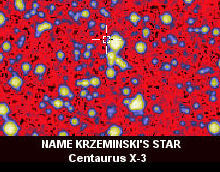 Krzeminski's Star & Centaurus X-3 — A Binary Pulsar with photon Bubbles
Krzeminski's Star & Centaurus X-3 — A Binary Pulsar with photon Bubbles
"Discovery of Kilohertz Fluctuations in Centaurus X-3: Evidence for Photon Bubble Oscillations (PBO) and Turbulence in a High-Mass X-Ray Binary Pulsar" The Astrophysical Journal, Volume 530, Issue 2, pp. 875-889
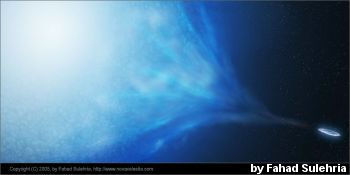 "[A]strophysicists today described their discovery of the fastest known X-ray emissions of any collapsed star in the universe." Discovery of kHz QPO from Cen X-3 Krzeminski's Star is a slightly evolved blue supergiant with a mass of 20.5 X
"[A]strophysicists today described their discovery of the fastest known X-ray emissions of any collapsed star in the universe." Discovery of kHz QPO from Cen X-3 Krzeminski's Star is a slightly evolved blue supergiant with a mass of 20.5 X  , a radius of 11.8 solar radii and a listed spectral type of O6.5II. It is estimate to be at a distance of 26,000-30,000 light years and have a visual mgnitude of 14.4 with an orbital period for Krzeminski's Star and J112115.2-603724 of 2.09 days, it being the visible component of the occulting spectroscopic binary system that forms the X-ray pulsar called Cen X-3. See: Krzeminski's Star Image credits: Top left Aladin desktop applet v5.018 and left by Fahad Sulehria, Nova Celestia Cick here for a list of pulsars in binary systems compiled by Wm. Robert Johnston. [13]
, a radius of 11.8 solar radii and a listed spectral type of O6.5II. It is estimate to be at a distance of 26,000-30,000 light years and have a visual mgnitude of 14.4 with an orbital period for Krzeminski's Star and J112115.2-603724 of 2.09 days, it being the visible component of the occulting spectroscopic binary system that forms the X-ray pulsar called Cen X-3. See: Krzeminski's Star Image credits: Top left Aladin desktop applet v5.018 and left by Fahad Sulehria, Nova Celestia Cick here for a list of pulsars in binary systems compiled by Wm. Robert Johnston. [13]
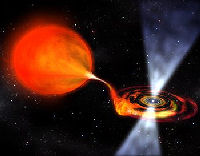 XTE J1739-285 — Fastest Spinner
XTE J1739-285 — Fastest Spinner
"Astronomers using ESA's gamma-ray observatory, Integral, have detected what appears to be the fastest spinning neutron star yet." Integral points to the fastest spinning neutron star PRESS RELEASE, Date Released: Friday, February 16, 2007. Source and Image Credits: European Space Agency & NASA/Dana Berry
"This neutron star shows X-ray bursts and rotates with 1122 revolutions per second. This is the speed record for rotation. It is accelerated by gas falling in from a near partner star. Possibly it isn't even made of neutrons, but of free, extremely dense quarks." XTE J1739-285 from the German website Astronomie: Die Sterne

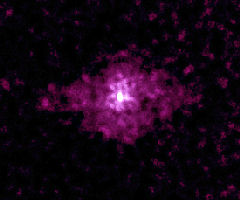 Pulsar J0205+6449 — Youngest
Pulsar J0205+6449 — Youngest
Take a set of pointing coordinates, feed them into a radio telescope and resolve the resulting image into the one at right and voila! Pulsar J020+6449 in the Supernovva Remnant 3C58. "Astronomers using the National Science Foundation's (NSF) newly commissioned Robert C. Byrd Green Bank Telescope (GBT) have detected remarkably faint radio signals from an 820 year-old pulsar, making it the youngest radio-emitting pulsar known." Source & image credits: From the German website of H. Heintzmann, Home Page. Image of the GBT from National Radio Astronomy Observatory, Green Bank Telescope
Photon Bubble Oscillations
Photon what? A more recent theoretical developement of binary neutron / pulsar research has to do with what is going on at the poles of the star as it accretes matter from it's companion star. Specifically "...researchers proposed some 10 years ago that when the neutron star is part of a binary system, the matter sucked onto the neutron star from the companion creates an unusual field of radiation bubbles that dance around the polar regions. When these bubbles burst, they produce a shower of X-rays that should be detectable by an X-ray telescope above the Earth's surface." [14] The team — in a rare example where both the seminal observations and new supporting theory have been carried out by the same people — conducting research into these "bubbles" decided that the 30,000 light years distance, 4.8 second spinning X-ray pulsar Centaurus X-3 would be the best canidate for their discovery and they were right:
 "This search resulted in discovery of two distinct quasi-periodic oscillation frequencies at about three thousandths and onethousandth of a second in the emergent radiation from Centaurus X-3, as well as the presence of a broad spectrum that extends to yet higher frequencies than have been found in any known collapsed object."
"This search resulted in discovery of two distinct quasi-periodic oscillation frequencies at about three thousandths and onethousandth of a second in the emergent radiation from Centaurus X-3, as well as the presence of a broad spectrum that extends to yet higher frequencies than have been found in any known collapsed object."
"The quasi-periodic oscillation frequencies and the properties of the broad spectrum they discovered matched predictions of their theory for photon bubbles in Centaurus X-3, providing the strongest support yet for the existence of photon bubbles in X-ray pulsars." [15] The image at left illustrates the theory of "Photon Bubble" formation at the magnetic poles of a neutron star. For a complete review see Discovery of kHz QPO from Cen X-3 from Sonoma State University website.
INTEGRAL Finds a 1122 revolutions per second Neutron Dynamo On October 17 of 2002 the INTEGRAL satellite ( INTErnational Gamma-Ray Astrophysics Laboratory ) was launched into high orbit from Baikonour in Kazakhstan, Russia. Its elliptical orbit is between 10,000 to 153,000 kilometers, half of the distance to the Moon, in order to keep it above Earth's radiation belts. The satellite was developed by the Italian Space Agency ( Italy's Alenia Spazio ) and constructed by the European Space Agency ( ESA ) with support from nearly 30 European companies and scientists from Poland, the Czech Republic, Russia and the USA. [16] INTEGRAL's continuing missions ( currently in extended operation till December 2012 ) are the detailed study of the many mysterious high energy objects called Gamma Rays and in this capacity it is the most sensitive gamma-ray observatory ever launched. Image: An artist's impression of ESA's orbiting gamma-ray observatory Integral from the ESA website [17]
On October 17 of 2002 the INTEGRAL satellite ( INTErnational Gamma-Ray Astrophysics Laboratory ) was launched into high orbit from Baikonour in Kazakhstan, Russia. Its elliptical orbit is between 10,000 to 153,000 kilometers, half of the distance to the Moon, in order to keep it above Earth's radiation belts. The satellite was developed by the Italian Space Agency ( Italy's Alenia Spazio ) and constructed by the European Space Agency ( ESA ) with support from nearly 30 European companies and scientists from Poland, the Czech Republic, Russia and the USA. [16] INTEGRAL's continuing missions ( currently in extended operation till December 2012 ) are the detailed study of the many mysterious high energy objects called Gamma Rays and in this capacity it is the most sensitive gamma-ray observatory ever launched. Image: An artist's impression of ESA's orbiting gamma-ray observatory Integral from the ESA website [17]
"Integral, in collaboration with NASA's Rossi X-ray Timing Explorer (RXTE), has detected what appears to be the fastest spinning neutron star yet. The neutron star
XTE J1739-285 was discovered during one of its active phases on 19 October 1999 by RXTE. While Integral was routinely monitoring the bulge of the Galaxy, XTE J1739-285 recently started to come back to life and Integral discovered the first short bursts of X-rays from the object. During the brightest burst, oscillations were taking place at a frequency of 1122 Hz, the highest spin frequency ever recorded. The exact breakup speed depends on the internal conditions of a neutron star, which are not precisely known. The 1122 Hz detection places a serious constraint on neutron star models." [18]
 An Object query on star XTE J1739-285 at the Simbad website returned the following basic information: [KRL2007b] 258 Low Mass X-ray Binary. The [KRL2007b] 258 is the INTEGRAL/IBIS All-Sky Survey in Hard X-rays nomenclature or other designator for XTE J1739-285. The catalog's information is presented based on the standard description for astronomical catalogues which in this case, is for the survey information pre and post, conducted with the INTEGRAL satellite. "We present results of an all-sky hard X-ray survey based on almost four years of observations with the IBIS telescope onboard the INTEGRAL observatory." Which is the Abstract description given by the authors for their catalog.
An Object query on star XTE J1739-285 at the Simbad website returned the following basic information: [KRL2007b] 258 Low Mass X-ray Binary. The [KRL2007b] 258 is the INTEGRAL/IBIS All-Sky Survey in Hard X-rays nomenclature or other designator for XTE J1739-285. The catalog's information is presented based on the standard description for astronomical catalogues which in this case, is for the survey information pre and post, conducted with the INTEGRAL satellite. "We present results of an all-sky hard X-ray survey based on almost four years of observations with the IBIS telescope onboard the INTEGRAL observatory." Which is the Abstract description given by the authors for their catalog.
The image at left shows ( circle & arrow ) where XTE J1739-285 is located ( not visible in this image ) in reference to it's stellar surroundings, RA 17 39 53.95 Dec -28 29 46.8. The image is from the Aladin previewer and is in RGB composition format — Red: SERC/SR/MAMA, Green:(average), Blue: SERC/J/MAMA meaning that this image was created with photographic plates obtained at the ESO/SERC for the southern region and digitized at the MAMA facility at the Centre d'Analyse des Images (CAI), Observatoire de Paris. [19]
5. The Planet, White Dwarf and Neutron Star - The Three Amigos
6. Isolated Neutron Star
§ Bibliography
- Pulsars - Imagine the Universe! at the NASA's Goddard Space Flight Center website, a service of the High Energy Astrophysics Science Archive Research Center (HEASARC), Dr. Alan Smale (Director), within the Astrophysics Science Division (ASD) at NASA's Goddard Space Flight Center.
- Miller, M. Coleman - Introduction to neutron stars, Mr. Miller is an Associate Professor of Astronomy, University of Maryland
- Calculating a Neutron Star's Density - from the RXTE Learning Center, a service of the Astrophysics Science Division at NASA/GSFC.
- Miller, Chris - How Black Holes and Neutron Stars Form website Copyright © 1998-2003 by Christopher Miller
- Neutron Stars/X-ray Binaries - from the Chandra X-Ray Observatory website's Field Guide
- Supernovas - from the Chandra X-Ray Observatory website's Field Guide
- Berger, Daniel J. Stars Copyright © 2001 by Daniel J. Berger. The above reprinting of Mr. Berger's work is under the following conditions: "This work may be copied without limit if its use is to be for non-profit educational purposes. Such copies may be by any method, present or future. The author requests only that this statement accompany all such copies. All rights to publication for profit are retained by the author."
- Chandra X-Ray Observatory above text quoted from the article Westerlund 1: Neutron Star Discovered Where a Black Hole Was Expected. Release Date: November 02, 2005
- 3-D Fly-Through of Cassiopeia A text and video from the Chandra X-Ray Observatory website's Animations & Video: Supernovas & Supernova Remnants page.
- Crab Nebula & Pulsar quoted text from the SolStation.com website. © 1998-2008 Sol Company. All Rights Reserved.
- Messier 1 quoted text from The Munich Astro Archive © 1995-2005 C. Kronberg. Mr. Kronberg's page is supported by the Universitäts-Sternwarte München and Leibniz-Rechenzentrum München
- New Star Appears in Taurus by Von Del Chamberlain, from Project ASTRO UTAH. Determination of the Distance to the Crab Nebula by MATTHEW J. BESTER & MATTEO J. PARIS J. Undergrad. Sci. 3: 57-62 (Summer 1996) Astronomy. "In 2008, the general consensus is that its distance from Earth is 2.0 ± 0.5 kpc (6.5 ± 1.6 kly)." from Wikipedia. Messier 1, Supernova Remnant M1, (NGC 1952) in Taurus Crab Nebula from the SEDS website, Hartmut Frommert & Christine Kronberg, Last Modification: August 22, 2007. M1: Filaments of the Crab Nebula (Info) this is an excellent page of information on the Crab Nebula and it's Pulsar/Neutron Star. These were the primary sources for the quoted distance given to the Crab Nebula.
- Krzeminski's Star information retrieved from the Simbad data query site, C.D.S. - SIMBAD4 rel 1.121a - 2009.05.15CEST02:28:22
- Fastest known X-ray emissions from a collapsed star support existence of exotic photon bubbles in an X-ray pulsar Created by Tim Graves, 4/7/99, HEAD press release of April 14, 1999
- [Ibid], Fastest known X-ray emissions from a collapsed star support existence of exotic photon bubbles in an X-ray pulsar
- Integral mission, a closer look at the Gamma Ray Universe from the Astronomy Today website, Author: Paul J. Henney. Copyright © 2000-2009, Astronomy Today.
- INTEGRAL mission report from 37th COSPAR meeting, Montreal, Canada 2008, European Space agency. File is in .pdf format.
- [Ibid], INTEGRAL mission report from 37th COSPAR meeting
- The ALADIN interactive sky atlas. A reference tool for identification of astronomical sources by F. Bonnarel, P. Fernique, O. Bienaymé, D. Egret, F. Genova, M. Louys, F. Ochsenbein, M. Wenger, and J.G. Bartlett, ASTRONOMY & ASTROPHYSICS APRIL I 2000, PAGE 33 SUPPLEMENT SERIES. This file is in .pdf format.
- Oldest Known Planet Identified HubbleSite News Release Number: STScI-2003-19 July 10, 2003, Credit: NASA, Brad Hansen (UCLA), Harvey Richer (UBC), Steinn Sigurdsson (Penn State), Ingrid Stairs (UBC), and Stephen Thorsett (UCSC).
- SEDS: Oldest Known Planet Identified in M4 from the Students for the Exploration and Development of Space website by Hartmut Frommert and Christine Kronberg.
- [Ibid], Oldest Known Planet Identified, HubbleSite News Release Number: STScI-2003-19
- A&B's Astronomy Lab, Fall 2001, No. 9 Extrasolar Systems, Aeree Chung & Ben Johnson's Astronomy Lab, Fall 2001
- Findings on Farthest and Oldest Known Planet and Companion White Dwarf Reported by UCLA Astronomer, Colleagues Using Hubble Space Telescope Data / UCLA Newsroom By Stuart Wolpert | 7/10/2003, © 2009 UC Regents
- RX J185635-3754 - an Isolated Neutron Star from a page written and maintained by F.M. Walter Professor of Astronomy, Department of Physics and Astronomy Stony Brook University, Stony Brook NY 11794-3800 (Last recorded update: 18 March 2003.). Also see Press Release
- Hubble Sees a Neutron Star Alone in Space from the HubbleSite News Release Number: STScI-1997-32, September 24, 1997
- Lone neutron star speeds through space from the website of the BBC NEWS division of Science/Nature for Friday, 10 November, 2000
- The Mystery of the Lonely Neutron Star, VLT images of the RX J1856.5-3754 region ESO Press Release 19/00 11 September 2000
- XMM-Newton finds the leader of the Magnificent Seven in a spin article from the ESA website Portal, 9 March 2007. For permission and terms of use see Copuyright page. The findings appear in the 10 March 2007 issue of The Astrophysical Journal, (657: L101—L104, 10 March 2007), in the article by Andrea Tiengo and Sandro Mereghetti (INAF—Istituto di Astrofisica Spaziale e Fisica Cosmica, Milan, Italy) titled: "XMM-NEWTON discovery of 7s pulsations in the isolated neutron star RX J1856.5-3754."
- The Magnificent Seven in the dusty prairie The role of interstellar absorption on the observed neutron star population by B. Posselt - S. B. Popov - F. Haberl - J. Trümper - R. Turolla - R. Neuhäuser arXiv:astro-ph/0609275v1 11 Sep 2006. This file in in .pdf format.
- Astronomers Pioneer New Method For Probing Exotic Matter article from the NASA/Goddard Space Flight Center Newsletter of August 27, 2007. The XMM-Newton paper appeared in the August 1 Astrophysical Journal Letters. The Suzaku paper has been submitted for publication in the same journal.
- [Ibid] M. Coleman Miller, Introduction to neutron stars
Additional Resources
- Centaurus X-3 page from Answers.com. Sci-Tech Dictionary. McGraw-Hill Dictionary of Scientific and Technical Terms. Copyright © 2003, 1994, 1989, 1984, 1978, 1976, 1974 by McGraw-Hill Companies, Inc. All rights reserved.
- Pulsating Radio Sources near the Crab Nebula Article, David H. Staelin and Edward C. Reifenstein III National Radio Astronomy Observatory, Edgemont Road, Charlottesville, Virginia. Science 27 December 1968: Vol. 162. no. 3861, pp. 1481 - 1483 DOI: 10.1126/science.162.3861.1481 © 2009 American Association for the Advancement of Science. All Rights Reserved.
- Integral points to the fastest spinning neutron star "Evidence for 1122Hz X-Ray burst Oscillations from the Neutron-Star X-Ray Transient XTE J1739-285", by P. Kaaret et al., will be published in The Astrophysical Journal on 10 March 2007 (http://arxiv.org/abs/astro-ph/0611716).
- Researchers Found Crusts of Neutron Stars are 10 Billion Times Stronger than Steel, from the Nanotechnology News Archive, Posted May 6th, 2009, Version 2.0 AZoNano - The A to Z of Nanotechnology...Copyright © 2009 by AZoM.com Pty.Ltd
- Discovery of Radio Pulsations from the X-ray Pulsar J0205+6449 in Supernova Remnant 3C 58 With the Green Bank Telescope by F. Camilo, I. H. Stairs, D. R. Lorimer, D. C. Backer, S. M. Ransom, B. Klein, R. Wielebinski, M. Kramer, M. A. McLaughlin, Z. Arzoumanian, and P. Müller Received 2002 March 8; accepted 2002 April 12; published 2002 April 24 The Astrophysical Journal, 571:L41—L44, 2002 May 20 © 2002. The American Astronomical Society. All rights reserved. Printed in U.S.A.
- Toward a mass and radius determination of the nearby isolated neutron star RX J185635-3754 from the The Astrophysical Journal 564 (2), 981-1006 (2002), authors: Pons, J. A.; Walter, F. M.; Lattimer, J. M.; Prakash, M.; Neuhäuser, R.; An, P. H.Max-Planck-Institute
- Stellar Evolution: The Life and Death of Our Luminous Neighbors by Arthur Holland and Mark Williams, University of Michigan
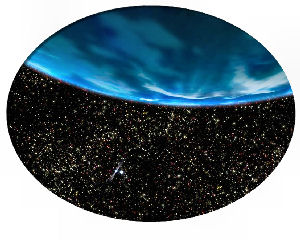 The Planet, White Dwarf and Neutron Star
The Planet, White Dwarf and Neutron Star
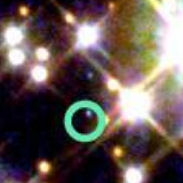 AT LEFT: "Hubble Space Telescope image of stars in globular cluster M4. Marked is a white-dwarf star, which is orbited by the pulsar called PSR B1620-26; this system had been discovered by radio astronomers in 1988. Only the white dwarf is visible in this image. The system has a third companion, the nature of which was subject to a decade-long discussion and research. Now, careful Hubble Space Telescope observations of the white dwarf have helped to reveal the nature of this third companion: It has a mass 2.5 times larger than planet Jupiter, and is thus recognized as a planet." [21] AT RIGHT: The green circle marks the position of the pulsar orbited by the oldest known planet, a closeup of the image at left. Here's the story of these three amigos, true residents of an unlikely, rough and crowded neighborhood:
AT LEFT: "Hubble Space Telescope image of stars in globular cluster M4. Marked is a white-dwarf star, which is orbited by the pulsar called PSR B1620-26; this system had been discovered by radio astronomers in 1988. Only the white dwarf is visible in this image. The system has a third companion, the nature of which was subject to a decade-long discussion and research. Now, careful Hubble Space Telescope observations of the white dwarf have helped to reveal the nature of this third companion: It has a mass 2.5 times larger than planet Jupiter, and is thus recognized as a planet." [21] AT RIGHT: The green circle marks the position of the pulsar orbited by the oldest known planet, a closeup of the image at left. Here's the story of these three amigos, true residents of an unlikely, rough and crowded neighborhood: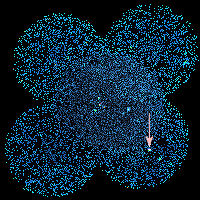
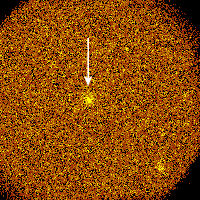 RX J185635-3754 — A Speeder Caught on Camera
RX J185635-3754 — A Speeder Caught on Camera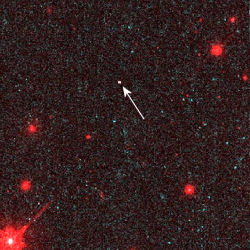 Then, on September 24, 1997, the HubbleSite NewsCenter released a new image and description of RX J185635-3754, this time in visible light, using the Hubble's Wide Field Planetary Camera 2. "Astronomers using NASA's Hubble Space Telescope have taken their first direct look, in visible light, at a lone neutron star. This offers a unique opportunity to pinpoint its size and to narrow theories about the composition and structure of this bizarre class of gravitationally collapsed, burned out stars." With a neutron star this close ( and getting closer ) astronomers have begun closing in on the theoretical and physical science of these object. Of the next round of surveys, astronomers were able to use the Hubble telescope "in an attempt to determine exactly how far away and how large the star is." The last of these, the size of neutron stars, is important to those theories that set the limits of how small a neutron star should be and why. In addition, it will also give astrophysicists "...an opportunity to better understand the transition matter undergoes when subjected to the extraordinary pressures and temperatures found in the intense gravitational field of a neutron star." [26] Image at right: Isolated Neutron Star RX J185635-3754. Credit: Fred Walter (State University of New York at Stony Brook) and
Then, on September 24, 1997, the HubbleSite NewsCenter released a new image and description of RX J185635-3754, this time in visible light, using the Hubble's Wide Field Planetary Camera 2. "Astronomers using NASA's Hubble Space Telescope have taken their first direct look, in visible light, at a lone neutron star. This offers a unique opportunity to pinpoint its size and to narrow theories about the composition and structure of this bizarre class of gravitationally collapsed, burned out stars." With a neutron star this close ( and getting closer ) astronomers have begun closing in on the theoretical and physical science of these object. Of the next round of surveys, astronomers were able to use the Hubble telescope "in an attempt to determine exactly how far away and how large the star is." The last of these, the size of neutron stars, is important to those theories that set the limits of how small a neutron star should be and why. In addition, it will also give astrophysicists "...an opportunity to better understand the transition matter undergoes when subjected to the extraordinary pressures and temperatures found in the intense gravitational field of a neutron star." [26] Image at right: Isolated Neutron Star RX J185635-3754. Credit: Fred Walter (State University of New York at Stony Brook) and 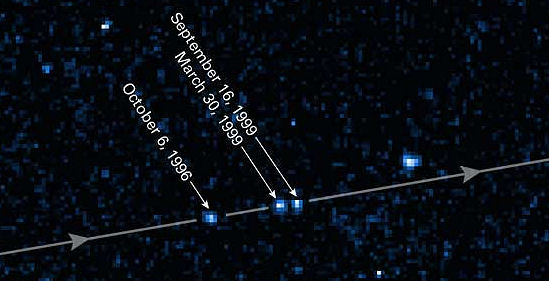 "Astronomers have identified a runaway neutron star that is hurtling in our direction at more than 100 times the speed of a supersonic jet...Astronomers will now study the object's physical properties, such as size, brightness and age, and use it to test their theories about neutron stars...The scientific importance of this object lies in the fact that the neutron star is isolated," said Frederick Walter of the State University of New York...It appears to be hot, not because it is accreting hydrogen gas as it moves through space but because it is still young and cooling off. Since we know its approximate age, we can test how fast neutron stars cool off...Because this is the closest and brightest of the few known isolated neutron stars, it is the easiest to study and is an excellent test-bed for nuclear astrophysical theories." [27] Image:
"Astronomers have identified a runaway neutron star that is hurtling in our direction at more than 100 times the speed of a supersonic jet...Astronomers will now study the object's physical properties, such as size, brightness and age, and use it to test their theories about neutron stars...The scientific importance of this object lies in the fact that the neutron star is isolated," said Frederick Walter of the State University of New York...It appears to be hot, not because it is accreting hydrogen gas as it moves through space but because it is still young and cooling off. Since we know its approximate age, we can test how fast neutron stars cool off...Because this is the closest and brightest of the few known isolated neutron stars, it is the easiest to study and is an excellent test-bed for nuclear astrophysical theories." [27] Image: 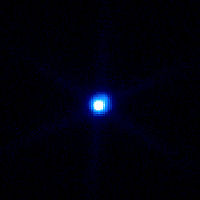 "RX J1856.5-3754 (also called RX J185635-3754, RX J185635-375, and various other designations) is a nearby neutron star in Corona Australis. It is believed to have been created by a supernova explosion of its companion star about one million years ago and is moving 108 km/s across the sky...It was originally thought to be about 150—200 light-years away, but further observations using the Chandra X-ray Observatory in 2002 appear to show that its distance is greater—about 450 light-years." From
"RX J1856.5-3754 (also called RX J185635-3754, RX J185635-375, and various other designations) is a nearby neutron star in Corona Australis. It is believed to have been created by a supernova explosion of its companion star about one million years ago and is moving 108 km/s across the sky...It was originally thought to be about 150—200 light-years away, but further observations using the Chandra X-ray Observatory in 2002 appear to show that its distance is greater—about 450 light-years." From 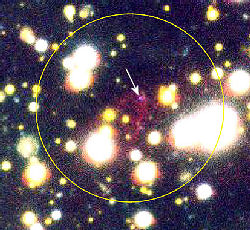 RX J185635-3754 Bowshock & Recent News from the ESA's XMM-Newton Observatory
RX J185635-3754 Bowshock & Recent News from the ESA's XMM-Newton Observatory North is to the lower right and East is upper right. The motion of the neutron star as seen on the sky (see the text) is towards East, exactly in the direction indicated by the nebula." From the
North is to the lower right and East is upper right. The motion of the neutron star as seen on the sky (see the text) is towards East, exactly in the direction indicated by the nebula." From the 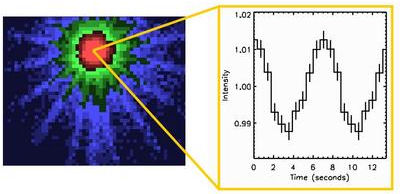 XMM-Newton finds the leader of the Magnificent Seven in a spin
XMM-Newton finds the leader of the Magnificent Seven in a spin There are many good reasons behind the efforts astronomers put into the detailed surveys of stellar objects such as neutron star RX J185635-3754. For starters, this star "is a key object in the study of its stellar category: it provides the second most perfect blackbody spectrum in the Universe, its distance and proper motion are measured, and the pulsations have the smallest pulsed fraction ever seen in an isolated neutron star. Until XMM-Newton's measurements, the knowledge of the rotation period was a missing key ingredient for the understanding of how these objects behave." Secondly, "[n]eutron stars slow down because their strong magnetic fields (one million, million times larger than the Earth's field) and fast rotation, produce electromagnetic radiation that drains their rotational energy. Measuring the deceleration of the object would give astronomers a clue about its magnetic field, which is responsible for creating the hot spot that produces the pulsation." Credit:
There are many good reasons behind the efforts astronomers put into the detailed surveys of stellar objects such as neutron star RX J185635-3754. For starters, this star "is a key object in the study of its stellar category: it provides the second most perfect blackbody spectrum in the Universe, its distance and proper motion are measured, and the pulsations have the smallest pulsed fraction ever seen in an isolated neutron star. Until XMM-Newton's measurements, the knowledge of the rotation period was a missing key ingredient for the understanding of how these objects behave." Secondly, "[n]eutron stars slow down because their strong magnetic fields (one million, million times larger than the Earth's field) and fast rotation, produce electromagnetic radiation that drains their rotational energy. Measuring the deceleration of the object would give astronomers a clue about its magnetic field, which is responsible for creating the hot spot that produces the pulsation." Credit: 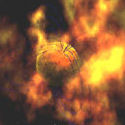
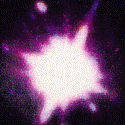
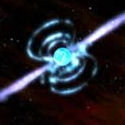
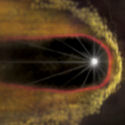 In the end, it can be said that Neutron stars are objects with very extreme physical properties, existing at the end of a very long stellar evolutionary line. As such, they afford both the astronomer and scientist the opportunity to delve into and study those areas of physics that otherwise wouldn't be possible. [32]
In the end, it can be said that Neutron stars are objects with very extreme physical properties, existing at the end of a very long stellar evolutionary line. As such, they afford both the astronomer and scientist the opportunity to delve into and study those areas of physics that otherwise wouldn't be possible. [32]